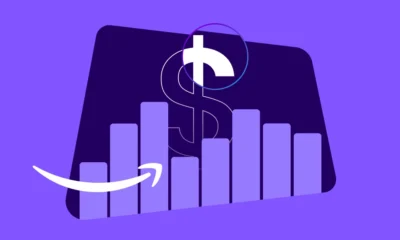SEO
Google On Traffic Metric & SEO

Google’s recent Search Off the Record podcast discussed the important details of SEO, including a thought provoking segment about how SEOs can benefit from realign their thoughts about traffic with other possibly more important goals.
Traffic As A Measure Of Success?
One of the most misinformed things that search marketers do is measure their success by citing traffic statistics. We’ve all seen the posts on Facebook or the articles on blogs, where a search marketer relates how they did X for a client and traffic exploded exponentially within months.
Link builders use traffic as a metric of success, content writers do it, SEOs do it.
The question that goes through my mind when I see that is, well, what effect did that have on sales or ad clicks?
Because if earnings remain flat then the traffic increase probably doesn’t matter and probably neither did the SEO work done for that traffic.
Ask any Pay Per Click expert or any affiliate marketer about the importance of conversions versus traffic and the response is clear: conversions are everything, not traffic.
Adam J Humphreys, CEO of search marketing and design consultancy Making 8 (LinkedIn profile) said this about success metrics:
“I focused on analytics early on and learned the language of business which is ROAS. This is all executives care about other than awareness.
Our job is to grow their business first as well as awareness second.
Many don’t know how to measure attribution from SEO.
Things like form fills and calls are almost always unmeasured and unreported. Clients get super excited when I talk about this because it’s almost like nobody ever cared about their success.”
What Google Says About SEO & Traffic
Martin Splitt asked the question about the business impact of traffic.
Martin asked:
“…when you say traffic drops, what does that mean to you? Is it impressions?
Are you going to Search Console and click on the Performance report and you just look at the impressions going down or clicks?
Or do you actually measure a real business impact? Like you’re selling only half as many things as you used to sell last month?”
John Mueller added his thoughts on the topic. He tried to explain why SEOs don’t focus on return on investment (ROI) or the impact of SEO on earnings.
He offered his guess that maybe it’s the time between doing SEO versus the impact of it.
He commented:
“Usually what I see from people is that they focus on the traffic on their site.
And they look at something like Analytics and they say, ‘Oh, I get so many visitors and so many visitors from search engines. And that number went down significantly.’
…And the aspect of ROI or kind of the value of that traffic, I see that as something that a lot of these SEOs tend not to focus on primarily, because my assumption is it’s just a very long lead time there.
Like you can turn your website off now, but you might still have people who are kind of like paying for something for a while.
And then, it’s like, wow…”
Mueller followed up is thoughts on why SEOs might not focus on earnings by discussing how website traffic can be a misleading metric because it doesn’t tell a lot about why something happened, it only shows what happened.
He continued:
“But I do think it’s something where I sometimes feel it’s misleading to just purely focus on the traffic.
And I see that with our sites as well. A year or two ago, we would rank for the word “Google” in Canada or something like that, the search documentation, of course.
I hope the Google website ranks for the word Google. But like the Search documentation would rank for the word Google somewhere on the first page.
And we got tons of traffic there, but all of that traffic was basically irrelevant.
And then if you only look at the traffic and all of that irrelevant traffic goes away, then it might look like you lost a lot of traffic, but actually it’s like all of those things are people that weren’t relevant for your site anyway.
So you almost need to look at the bigger picture of all of the traffic that’s gone, but also keep in mind like, well, a lot of this was useless and I should maybe focus on the queries that people use, and then clicks and impressions for those, or individual like lower level pages of the site and kind of track those a little bit more.”
Traffic And SEO
SEOs promote themselves through case studies showing all the traffic their efforts brought. But those studies are hollow and maybe even deceptive if there’s absolutely no reference to how much sales lift resulted after their effort.
Link builders do a similar thing where they promote all the hundreds or thousands of links they acquired for a client and sometimes mention the lift in traffic. Just as consistently as SEOs, they always leave out the effect on sales or earnings.
Why do they do that? I suspect that many of those SEOs have never actually built a business around monetizing affiliate sales or ad clicks and thus don’t have first hand experience from that side of the SEO fence.
A lot of the old school SEOs like myself learned what we know from building and monetizing websites, maybe because client work for SEO wasn’t really as much of a thing then as it is now.
Using traffic as a metric is useful for measuring the impact of SEO but traffic should not be the goal of SEO. The reason is because there are different kinds of traffic.
Some traffic converts into sales. Some traffic has a lead time from the first visit to the sales. Some traffic is useful for building a brand name.
But some traffic is not relevant or useful.
When it comes to diagnosing traffic drops related to ranking changes, it may be helpful to understand if there’s any impact on sales and if not, to understand why the traffic drop had no monetary impact and if content and SEO efforts might be better directed in a different direction.
Listen to the Google podcast, Search Off the Record: SEO Is In The Details.
SEO
International SEO For 2024: 9-Point Checklist For Success

Getting your international SEO strategy right can be an elusive feat.
There are a lot more factors at play than people give credit for, and it’s often a thankless job.
A successful international SEO strategy requires a deep knowledge of your company’s commercial strategy as well as technical SEO knowledge, cultural sensitivity, and excellent data skills.
Yet the industry often regards international SEO as just your hreflang setup.
In this article, I will distill the complexities of international SEO success into an actionable step-by-step list that will take you from beginner to advanced practitioner. Let’s begin!
Part I: Be Commercially Aware
1. Understand Why Your Company Is Going International
Companies can grow by expanding their products and services, focusing on gaining market penetration or expanding into new markets.
While your team’s goal might be traffic, leads, or revenue, the leadership team is likely working under a different set of parameters. Most of the time, leadership’s ultimate goal is to maximize shareholder value.
- In founder-owned companies, growth goals might be slower and more sustainable, usually aimed at maintaining and growing profitability.
- VC-owned companies have high growth goals because they must provide their investors with a return that’s higher than the stock market. This is what is known as the alpha, or your company’s ability to beat the market in growth.
- Publicly traded companies are likely aiming to grow their share value.
- Startups, depending on their maturity stage, are likely looking to prove product-market fit or expand their reach fast to show that their operations are scalable and have the potential to be profitable in the future. The goal of this is to aid in raising further capital from investors.
Understanding why businesses go international is essential for informing your SEO decisions. What’s best practice for SEO isn’t always what’s best for business.
You must adapt your strategy to your company’s growth model.
- Companies choosing to grow sustainably and maintain profitability will likely expand more slowly to a market that resembles their core market.
- VC-owned companies will be able to invest in a wider range of countries, with a smaller concern for providing their users with an experience on par with that of their core markets.
- Startups can try to beat their competitors to market by expanding quickly and throwing a lot of money at the project, or they might be concerned with cash flow and try to expand fast but cut corners by using automatic translation.
2. Stack Rank Your Target Markets To Prioritize Your Investment
I promise I’ll get to hreflang implementation soon, but so much about international SEO has to do with commercial awareness – so bear with me; this will make you a better professional.
Many companies have different market tiers to reflect how much of a priority each market is. Market prioritization can happen using many different metrics, such as:
- Average order value or lifetime customer value.
- Amount of investment required.
- Market size.
- And market similarity.
American companies often prioritize developed English-speaking countries such as the UK, Canada, or Australia. These are most similar to their core market, and most of their market knowledge will be transferable.
After that, companies are likely to target large European economies, such as Germany and France. They might also target the LatAm market and Spain in the same effort.
The last prioritization tier can vary widely among companies, with a focus on the Nordic, Brazilian, or Asian markets.
Part II: Know Your Tech
3. Define Your International URL Structure
When doing international SEO, there are 4 different possible URL structures, each with its pros and cons.
ccTLD Structure
A ccTLD structure is set up to target different countries based on the domain type.
This structure is not ideal for companies that target different languages rather than different countries. For example, a .es website is targeting Spain, not the Spanish language.
An advantage to this kind of structure is that the ccTLD sends a very strong localization signal to search engines as to what market they are targeting, and they can lead to improved trust and CTR in your core country.
On the other hand, ccTLDs can dilute your site’s authority, as links will be spread across domains rather than concentrated on the .com.
gTLD With Subdirectories
This is my personal favorite when it comes to international SEO.
These URL structures can look like website.com/en if they’re targeting languages or website.com/en-gb if they’re targeting countries.
This configuration aggregates the authority you gain across your different territories into a single domain, it’s cheaper to maintain, and the .com TLD is widely recognizable by users worldwide.
On the other hand, this setup can look less personalized to people outside the US, who might wonder if you can service their markets.
gTLD With Subdomains
This setup involves placing international content on a subdomain like us.website.com. While once popular, it’s slipping in favor because it doesn’t bring anything unique to the table anymore.
This setup offers a clear signal to users and search engines about the intended audience of a specific subdomain.
However, subdomains often face issues with SEO, as Google tends to view them as separate entities. This separation can dilute link, similar to the ccTLD approach but without the geo-targeting advantages.
gTLD With Parameters
This is the setup where you add parameters at the end of the URL to indicate the language of the page, such as website.com/?lang=en.
I strongly advise against this setup, as it can present multiple technical SEO challenges and trust issues.
4. Understand Your Hreflang Setup
In the words of John Mueller: hreflang can be one of the most complex aspects of SEO.
Hreflang reminds me of a multilingual form of a canonical tag, where we tell search engines that one document is a version of the other and explain the relationship between them.
I find hreflang implementation very interesting from a technical point of view. Because development teams mostly manage it, and it can be very much hit or miss.
Often, hreflang is constructed from existing fields in your content management system (CMS) or content database.
You might find that your development team is pulling the HTML lang tag, which follows a different ISO standard than hreflang, leading to a broken implementation.
Other times, there is a field in your CMS that your development team pulls from to build your hreflang setup.
Finding out how your hreflang tags are generated can be extremely helpful in identifying the sources of different issues or mitigating potential risks.
So speak to your engineering team and ask them how you’re currently generating hreflang.
5. Implement Hreflang Without Errors
There are three ways to implement hreflang on your site:
- On your sitemap.
- Through your HTTP header.
- On your HTML head.
The method most of us are most familiar with is the HTML head. And while you can use more than one method, they should match each other perfectly. Otherwise, you risk confusing search engines.
Here are some basic rules for getting it done correctly:
- In your hreflang implementation, the URL must include domain and protocol.
- You must follow the ISO 639-1 language codes – don’t go around making up your own.
- Hreflang tags must be reciprocal. If the page you’re listing as a language alternative does not list you back, your implementation won’t work.
- Audit your hreflang regularly. My favorite tool for this, since it added the hreflang cluster analysis and link graphs, is Ahrefs. For the record, Ahrefs is not paying me to say this; it’s a genuine recommendation and has helped me a lot in my work.
- You should only have one page per language.
- Your hreflang URLs should be self-canonicalizing and respond with a 200 code.
Follow the above rules, and you’ll avoid the most common hreflang mistakes that SEO pros make.
And if you’re interested in the technical SEO aspect beyond hreflang, I recommend reading Mind your language by Rob Owen.
Part III: Invest In Content Incrementally
6. Translate Your Top-performing Content Topics
Now that you have the basic commercial and technical knowledge covered, you’re ready to start creating a content strategy.
You likely have a wealth of content in your core market that can be recycled. But you want to focus on translating high-converting topics, not just any topic; otherwise, you might be wasting your budget!
Let’s go step by step.
Cluster Your Website’s Content By Topic
- Crawl your site using your favorite SEO tool and extract the URL and H1.
- Use ChatGPT to classify that list of URLs into topics. You might already know what you usually write about, so include those topics in your prompt. You don’t want to have a classification that’s too granular, so you can prompt chatGPT to only create groups with a minimum of 10 URLs (adjust this to reflect the size of your website) and class everything else as other. This is an example of what your prompt might look like: “I will provide you with a list of article titles and their corresponding URL. Classify this list into the following topics: survey best practices, research and analysis, employee surveys, market research and others. Return this in a table format with the URL, title and group name.”
- Start a spreadsheet with all your URLs in the first column, titles in the second column, and the group they belong to in the third column.
Measure Your Performance By Topic
- Export your GSC data and use a =VLOOKUP formula to match your clicks to your URLs.
- Export your conversion data and use a =VLOOKUP formula to match your conversions (leads, sales, sign-ups, or revenue) to the right URL.
- You can then copy your topics column onto a new sheet. Remove duplicates and use the =SUMIF formula to aggregate your click data and conversion data by topic.
Choose What Topics You’ll Be Translating First
Using this data, you can now choose what topics are most likely to drive conversions based on your core market data. Choose how many topics or pieces of content you’ll be translating based on your budget.
Personally, I like translating one topic at a time because I’ve found that generating topical authority on one specific topic makes it easier for me to rank on an adjacent topic that I write about next.
7. Localize Your English Content
Once you’re set up with all your key pages and a few content topics, it’s time to evaluate your investment and see where you could be getting a bigger return.
At this stage, many companies have translated their content into a few different languages and likely copied the US content into their UK and Australian sites. Now that you’ve done some translation, it’s time to work on localization.
If you’ve just copied your US content into your UK and Australian sites, your Google Search Console indexing report might be screaming at you, “Duplicate, Google selected a different canonical than the user.”
A very easy fix that could yield great returns is to localize your English content to the nuances of those English-speaking markets.
You will want to instruct your translation and localization providers to adapt the spellings of certain words, change the choice of words, introduce local expressions, and update any cited statistic for the US with their local equivalent.
For example, if I’m targeting a British audience, “analyze” becomes “analyse,” a “stroller” becomes a “pram,” and “soccer” becomes “football.”
8. Invest In In-market Content
Once you’ve got the basics in place, you can start tackling the specific needs of other markets. This strategy is expensive, and you should only use it in your priority markets, but it can really set you apart from your competitors.
For this, you will need to work with a local linguist to identify pain points, use cases, or needs exclusive to your target market.
For example, if France suddenly made it mandatory to run a diversity and inclusion study for companies with over 250 employees, I’d want to know this and create some content on DEI surveys at SurveyMonkey.
9. Integrate With Other Content Workflows
In step six, we evaluated our top-performing content, chose the best articles to translate, and got it all down. But wait. Some of these source articles have been updated. And there is even more content now!
To run a successful international SEO campaign you must integrate with all the other teams publishing content within your organization.
Usually, the teams creating content in an organization are SEO, content, PR, product marketing, demand generation, customer marketing, customer service, customer education, or solutions engineering.
That’s a lot, and you won’t be able to integrate with everyone all at once. Prioritize the teams that create the most revenue-generating content, such as SEO, content, or product marketing.
Working with these teams, you will have to establish a process for what happens when they create a new piece, update some content, or remove an existing piece.
These processes can differ for everyone, but I can tell you what I do with my team and hope it inspires you.
- When a piece of content that’s already been localized into international markets is updated, we get the content in a queue to be re-localized the next quarter.
- When they create a new piece of content, we evaluate its performance, and if it’s performing above average, we add it to a localization queue for the next quarter.
- When they change the URL of a piece of content or delete it, all international sites must follow suit at the same time, since due to some technical limitations, not making the change globally would create some hreflang issues.
Wrapping Up
International SEO is vast and complex, and no article can cover it all, but many interesting resources have been created by SEO pros across the community for those who want to learn more.
Navigating the complexities of international SEO is no small feat. It’s an intricate dance of aligning commercial strategies with technical precision, cultural insights, and data-driven decisions.
From understanding your company’s core motives for global expansion to meticulously implementing hreflang tags and localizing content, every step plays a crucial role in building a successful international presence.
More resources:
Featured Image: BritCats Studio/Shutterstock
SEO
Google’s AI Vision Driven By Panic, Not Users: Former Product Manager

A 16-year Google veteran is raising concerns about the company’s current focus on AI, labeling it a “panic reaction” driven by fear of falling behind competitors.
Scott Jenson, who left Google last month, took to LinkedIn to critique the tech giant’s AI projects as “poorly motivated and driven by this mindless panic that as long as it had ‘AI’ in it, it would be great.”
Veteran’s Criticism Of Google’s AI Focus
Jenson stated that Google’s vision of creating an AI assistant for its ecosystem is “pure catnip” fueled by the fear of letting someone else get there first.
He parallels the ill-fated Google+ product, which he calls a “similar hysterical reaction” to Facebook’s rise.
Jenson wrote:
“This exact thing happened 13 years ago with Google+ (I was there for that fiasco as well). That was a similar hysterical reaction but to Facebook.”
Lack Of User-Driven Motivation
Jenson argues that Google’s strategy lacks motivation driven by genuine user needs, a sentiment echoed by a recent Gizmodo article that described this year’s Google I/O developer conference as “the most boring ever.”
The article, which Jenson linked to in his post, criticized Google for failing to clarify how Gemini’s new AI technology would integrate into its existing products and enhance the user experience.
See Jenson’s full post below:
Can You Turn Off Google’s AI Overviews?
One prime example of Google’s AI overreach is the AI overviews feature, which generates summaries to directly answer search queries by ingesting information from across the web.
This controversial move has sparked legal battles, with publishers accusing Google of violating intellectual property rights and unfairly profiting from their content without permission.
Related: Google’s AI Overviews Documentation: Key SEO Insights
Turning Off AI Overviews
While Google doesn’t provide an official setting to turn off AI overviews, a viral article from Tom’s Hardware suggests using browser extensions.
Alternatively, you can configure Chrome to go directly to web search results, bypassing the AI-generated overviews.
Here are the steps:
- Open Chrome settings by clicking the three dots in the top-right corner and selecting “Settings” from the menu.
- In the Settings window, click on the “Search Engine” tab on the left side.
- Under the “Search Engine” section, click “Manage search engines and site search.”
- Scroll down to the “Site search” area and click “Add” to create a new entry.
In the new entry, enter the following details:
- Name: Google (Web)
- Shortcut: www.google.com
- URL: {google:baseURL}/search?udm=14&q=%s
- Click “Add“
Lastly, click the three dots next to the new “Google (Web)” entry and select “Make default.”
 Screenshot from: chrome://settings/searchEngines, May 2024.
Screenshot from: chrome://settings/searchEngines, May 2024.After following these steps, Chrome will now default to showing regular web search results instead of the AI overview summaries when you perform searches from the address bar.
Tensions Over Data Usage
The controversy surrounding AI overviews creates tension between tech companies and content creators over using online data for AI training.
Publishers argue that Google’s AI summaries could siphon website traffic, threatening independent creators’ revenue streams, which rely on search referrals.
The debate reflects the need for updated frameworks to balance innovation and fair compensation for content creators, maintaining a sustainable open internet ecosystem.
FAQ
What concerns has Scott Jenson raised about Google’s AI focus?
Scott Jenson, a former Google product manager, has expressed concerns that Google’s current AI focus is more of a “panic reaction” to stay ahead of competitors rather than addressing user needs. He critiques Google’s AI initiatives as poorly motivated and driven by a fear of letting others get ahead.
How does Scott Jenson compare Google’s AI strategy to past projects?
Jenson parallels Google’s current AI focus and the company’s response to Facebook years ago with Google+. He describes both as “hysterical reactions” driven by competition, which, in the case of Google+, resulted in a product that failed to meet its objectives.
Why are content creators concerned about Google’s AI overviews?
Content creators worry that Google’s AI overviews, which generate summaries by ingesting web content, could reduce site traffic. They argue that this practice is unfair as it uses their content without permission and impacts their revenue streams that rely on search referrals.
How can users turn off Google’s AI overviews in Chrome?
Although no official setting exists to disable AI overviews, users can use a workaround by enabling a specific Chrome setting or using a browser extension.
Here are the steps:
- Open Chrome settings by clicking the three dots in the top-right corner and selecting “Settings” from the menu.
- In the Settings window, click on the “Search Engine” tab on the left side.
- Under the “Search Engine” section, click “Manage search engines and site search.”
- Scroll down to the “Site search” area and click “Add” to create a new entry.
In the new entry, enter the following details:
-
- Name: Google (Web)
- Shortcut: www.google.com
- URL: {google:baseURL}/search?udm=14&q=%s
- Click “Add“
This will force Chrome to skip AI-generated overviews and show the classic list of web links.
Featured Image: Sira Anamwong/Shutterstock
SEO
How To Use ChatGPT For Keyword Research

Anyone not using ChatGPT for keyword research is missing a trick.
You can save time and understand an entire topic in seconds instead of hours.
In this article, I outline my most effective ChatGPT prompts for keyword research and teach you how I put them together so that you, too, can take, edit, and enhance them even further.
But before we jump into the prompts, I want to emphasize that you shouldn’t replace keyword research tools or disregard traditional keyword research methods.
ChatGPT can make mistakes. It can even create new keywords if you give it the right prompt. For example, I asked it to provide me with a unique keyword for the topic “SEO” that had never been searched before.
“Interstellar Internet SEO: Optimizing content for the theoretical concept of an interstellar internet, considering the challenges of space-time and interplanetary communication delays.”
Although I want to jump into my LinkedIn profile and update my title to “Interstellar Internet SEO Consultant,” unfortunately, no one has searched that (and they probably never will)!
You must not blindly rely on the data you get back from ChatGPT.
What you can rely on ChatGPT for is the topic ideation stage of keyword research and inspiration.
ChatGPT is a large language model trained with massive amounts of data to accurately predict what word will come next in a sentence. However, it does not know how to do keyword research yet.
Instead, think of ChatGPT as having an expert on any topic armed with the information if you ask it the right question.
In this guide, that is exactly what I aim to teach you how to do – the most essential prompts you need to know when performing topical keyword research.
Best ChatGPT Keyword Research Prompts
The following ChatGPT keyword research prompts can be used on any niche, even a topic to which you are brand new.
For this demonstration, let’s use the topic of “SEO” to demonstrate these prompts.
Generating Keyword Ideas Based On A Topic
What Are The {X} Most Popular Sub-topics Related To {Topic}?
The first prompt is to give you an idea of the niche.
As shown above, ChatGPT did a great job understanding and breaking down SEO into three pillars: on-page, off-page & technical.
The key to the following prompt is to take one of the topics ChatGPT has given and query the sub-topics.
What Are The {X} Most Popular Sub-topics Related To {Sub-topic}?
For this example, let’s query, “What are the most popular sub-topics related to keyword research?”
Having done keyword research for over 10 years, I would expect it to output information related to keyword research metrics, the types of keywords, and intent.
Let’s see.
 Screenshot from ChatGPT 4, April 2024
Screenshot from ChatGPT 4, April 2024Again, right on the money.
To get the keywords you want without having ChatGPT describe each answer, use the prompt “list without description.”
Here is an example of that.
List Without Description The Top {X} Most Popular Keywords For The Topic Of {X}
You can even branch these keywords out further into their long-tail.
Example prompt:
List Without Description The Top {X} Most Popular Long-tail Keywords For The Topic “{X}”
 Screenshot ChatGPT 4,April 2024
Screenshot ChatGPT 4,April 2024List Without Description The Top Semantically Related Keywords And Entities For The Topic {X}
You can even ask ChatGPT what any topic’s semantically related keywords and entities are!
 Screenshot ChatGPT 4, April 2024
Screenshot ChatGPT 4, April 2024Tip: The Onion Method Of Prompting ChatGPT
When you are happy with a series of prompts, add them all to one prompt. For example, so far in this article, we have asked ChatGPT the following:
- What are the four most popular sub-topics related to SEO?
- What are the four most popular sub-topics related to keyword research
- List without description the top five most popular keywords for “keyword intent”?
- List without description the top five most popular long-tail keywords for the topic “keyword intent types”?
- List without description the top semantically related keywords and entities for the topic “types of keyword intent in SEO.”
Combine all five into one prompt by telling ChatGPT to perform a series of steps. Example:
“Perform the following steps in a consecutive order Step 1, Step 2, Step 3, Step 4, and Step 5”
Example:
“Perform the following steps in a consecutive order Step 1, Step 2, Step 3, Step 4 and Step 5. Step 1 – Generate an answer for the 3 most popular sub-topics related to {Topic}?. Step 2 – Generate 3 of the most popular sub-topics related to each answer. Step 3 – Take those answers and list without description their top 3 most popular keywords. Step 4 – For the answers given of their most popular keywords, provide 3 long-tail keywords. Step 5 – for each long-tail keyword offered in the response, a list without descriptions 3 of their top semantically related keywords and entities.”
Generating Keyword Ideas Based On A Question
Taking the steps approach from above, we can get ChatGPT to help streamline getting keyword ideas based on a question. For example, let’s ask, “What is SEO?”
“Perform the following steps in a consecutive order Step 1, Step 2, Step 3, and Step 4. Step 1 Generate 10 questions about “{Question}”?. Step 2 – Generate 5 more questions about “{Question}” that do not repeat the above. Step 3 – Generate 5 more questions about “{Question}” that do not repeat the above. Step 4 – Based on the above Steps 1,2,3 suggest a final list of questions avoiding duplicates or semantically similar questions.”
 Screenshot ChatGPT 4, April 2024
Screenshot ChatGPT 4, April 2024Generating Keyword Ideas Using ChatGPT Based On The Alphabet Soup Method
One of my favorite methods, manually, without even using a keyword research tool, is to generate keyword research ideas from Google autocomplete, going from A to Z.
-
 Screenshot from Google autocomplete, April 2024
Screenshot from Google autocomplete, April 2024
You can also do this using ChatGPT.
Example prompt:
“give me popular keywords that includes the keyword “SEO”, and the next letter of the word starts with a”
 Screenshot from ChatGPT 4, April 2024
Screenshot from ChatGPT 4, April 2024Tip: Using the onion prompting method above, we can combine all this in one prompt.
“Give me five popular keywords that include “SEO” in the word, and the following letter starts with a. Once the answer has been done, move on to giving five more popular keywords that include “SEO” for each letter of the alphabet b to z.”
Generating Keyword Ideas Based On User Personas
When it comes to keyword research, understanding user personas is essential for understanding your target audience and keeping your keyword research focused and targeted. ChatGPT may help you get an initial understanding of customer personas.
Example prompt:
“For the topic of “{Topic}” list 10 keywords each for the different types of user personas”
 Screenshot from ChatGPT 4, April 2024
Screenshot from ChatGPT 4, April 2024You could even go a step further and ask for questions based on those topics that those specific user personas may be searching for:
 Screenshot ChatGPT 4, April 2024
Screenshot ChatGPT 4, April 2024As well as get the keywords to target based on those questions:
“For each question listed above for each persona, list the keywords, as well as the long-tail keywords to target, and put them in a table”
 Screenshot from ChatGPT 4, April 2024
Screenshot from ChatGPT 4, April 2024Generating Keyword Ideas Using ChatGPT Based On Searcher Intent And User Personas
Understanding the keywords your target persona may be searching is the first step to effective keyword research. The next step is to understand the search intent behind those keywords and which content format may work best.
For example, a business owner who is new to SEO or has just heard about it may be searching for “what is SEO.”
However, if they are further down the funnel and in the navigational stage, they may search for “top SEO firms.”
You can query ChatGPT to inspire you here based on any topic and your target user persona.
SEO Example:
“For the topic of “{Topic}” list 10 keywords each for the different types of searcher intent that a {Target Persona} would be searching for”
ChatGPT For Keyword Research Admin
Here is how you can best use ChatGPT for keyword research admin tasks.
Using ChatGPT As A Keyword Categorization Tool
One of the use cases for using ChatGPT is for keyword categorization.
In the past, I would have had to devise spreadsheet formulas to categorize keywords or even spend hours filtering and manually categorizing keywords.
ChatGPT can be a great companion for running a short version of this for you.
Let’s say you have done keyword research in a keyword research tool, have a list of keywords, and want to categorize them.
You could use the following prompt:
“Filter the below list of keywords into categories, target persona, searcher intent, search volume and add information to a six-column table: List of keywords – [LIST OF KEYWORDS], Keyword Search Volume [SEARCH VOLUMES] and Keyword Difficulties [KEYWORD DIFFICUTIES].”
-
 Screenshot from ChatGPT, April 2024
Screenshot from ChatGPT, April 2024
Tip: Add keyword metrics from the keyword research tools, as using the search volumes that a ChatGPT prompt may give you will be wildly inaccurate at best.
Using ChatGPT For Keyword Clustering
Another of ChatGPT’s use cases for keyword research is to help you cluster. Many keywords have the same intent, and by grouping related keywords, you may find that one piece of content can often target multiple keywords at once.
However, be careful not to rely only on LLM data for clustering. What ChatGPT may cluster as a similar keyword, the SERP or the user may not agree with. But it is a good starting point.
The big downside of using ChatGPT for keyword clustering is actually the amount of keyword data you can cluster based on the memory limits.
So, you may find a keyword clustering tool or script that is better for large keyword clustering tasks. But for small amounts of keywords, ChatGPT is actually quite good.
A great use small keyword clustering use case using ChatGPT is for grouping People Also Ask (PAA) questions.
Use the following prompt to group keywords based on their semantic relationships. For example:
“Organize the following keywords into groups based on their semantic relationships, and give a short name to each group: [LIST OF PAA], create a two-column table where each keyword sits on its own row.
-
 Screenshot from ChatGPT, April 2024
Screenshot from ChatGPT, April 2024
Using Chat GPT For Keyword Expansion By Patterns
One of my favorite methods of doing keyword research is pattern spotting.
Most seed keywords have a variable that can expand your target keywords.
Here are a few examples of patterns:
1. Question Patterns
(who, what, where, why, how, are, can, do, does, will)
“Generate [X] keywords for the topic “[Topic]” that contain any or all of the following “who, what, where, why, how, are, can, do, does, will”
 Screenshot ChatGPT 4, April 2024
Screenshot ChatGPT 4, April 20242. Comparison Patterns
Example:
“Generate 50 keywords for the topic “{Topic}” that contain any or all of the following “for, vs, alternative, best, top, review”
 Screenshot ChatGPT 4, April 2024
Screenshot ChatGPT 4, April 20243. Brand Patterns
Another one of my favorite modifiers is a keyword by brand.
We are probably all familiar with the most popular SEO brands; however, if you aren’t, you could ask your AI friend to do the heavy lifting.
Example prompt:
“For the top {Topic} brands what are the top “vs” keywords”
 Screenshot ChatGPT 4, April 2024
Screenshot ChatGPT 4, April 20244. Search Intent Patterns
One of the most common search intent patterns is “best.”
When someone is searching for a “best {topic}” keyword, they are generally searching for a comprehensive list or guide that highlights the top options, products, or services within that specific topic, along with their features, benefits, and potential drawbacks, to make an informed decision.
Example:
“For the topic of “[Topic]” what are the 20 top keywords that include “best”
 Screenshot ChatGPT 4, April 2024
Screenshot ChatGPT 4, April 2024Again, this guide to keyword research using ChatGPT has emphasized the ease of generating keyword research ideas by utilizing ChatGPT throughout the process.
Keyword Research Using ChatGPT Vs. Keyword Research Tools
Free Vs. Paid Keyword Research Tools
Like keyword research tools, ChatGPT has free and paid options.
However, one of the most significant drawbacks of using ChatGPT for keyword research alone is the absence of SEO metrics to help you make smarter decisions.
To improve accuracy, you could take the results it gives you and verify them with your classic keyword research tool – or vice versa, as shown above, uploading accurate data into the tool and then prompting.
However, you must consider how long it takes to type and fine-tune your prompt to get your desired data versus using the filters within popular keyword research tools.
For example, if we use a popular keyword research tool using filters, you could have all of the “best” queries with all of their SEO metrics:
-
 Screenshot from Ahrefs Keyword Explorer, March 2024
Screenshot from Ahrefs Keyword Explorer, March 2024
And unlike ChatGPT, generally, there is no token limit; you can extract several hundred, if not thousands, of keywords at a time.
As I have mentioned multiple times throughout this piece, you cannot blindly trust the data or SEO metrics it may attempt to provide you with.
The key is to validate the keyword research with a keyword research tool.
ChatGPT For International SEO Keyword Research
ChatGPT can be a terrific multilingual keyword research assistant.
For example, if you wanted to research keywords in a foreign language such as French. You could ask ChatGPT to translate your English keywords;
 Screenshot ChatGPT 4, Apil 2024
Screenshot ChatGPT 4, Apil 2024- The key is to take the data above and paste it into a popular keyword research tool to verify.
- As you can see below, many of the keyword translations for the English keywords do not have any search volume for direct translations in French.
 Screenshot from Ahrefs Keyword Explorer, April 2024
Screenshot from Ahrefs Keyword Explorer, April 2024But don’t worry, there is a workaround: If you have access to a competitor keyword research tool, you can see what webpage is ranking for that query – and then identify the top keyword for that page based on the ChatGPT translated keywords that do have search volume.
-
-
 Screenshot from Ahrefs Keyword Explorer, April 2024
Screenshot from Ahrefs Keyword Explorer, April 2024
Or, if you don’t have access to a paid keyword research tool, you could always take the top-performing result, extract the page copy, and then ask ChatGPT what the primary keyword for the page is.
Key Takeaway
-
ChatGPT can be an expert on any topic and an invaluable keyword research tool. However, it is another tool to add to your toolbox when doing keyword research; it does not replace traditional keyword research tools.
As shown throughout this tutorial, from making up keywords at the beginning to inaccuracies around data and translations, ChatGPT can make mistakes when used for keyword research.
You cannot blindly trust the data you get back from ChatGPT.
However, it can offer a shortcut to understanding any topic for which you need to do keyword research and, as a result, save you countless hours.
But the key is how you prompt.
The prompts I shared with you above will help you understand a topic in minutes instead of hours and allow you to better seed keywords using keyword research tools.
It can even replace mundane keyword clustering tasks that you used to do with formulas in spreadsheets or generate ideas based on keywords you give it.
Paired with traditional keyword research tools, ChatGPT for keyword research can be a powerful tool in your arsenal.
More resources:
Featured Image: Tatiana Shepeleva/Shutterstock
-

 MARKETING6 days ago
MARKETING6 days ago3 Contextual Link-Building Strategies That Actually Work
-

 MARKETING7 days ago
MARKETING7 days agoGoogle’s Surgical Strike on Reputation Abuse
-

 PPC5 days ago
PPC5 days agoGoogle Ads Releases New Search Partner Insights & Controls Following Advertiser Concerns
-

 PPC6 days ago
PPC6 days ago5 Campaign Red Flags And Why They Matter
-

 SEO5 days ago
SEO5 days agoChatbots And AI Search Engines Converge: Key Strategies For SEO
-

 SEO5 days ago
SEO5 days ago14 Ways to Use AI for Better, Faster SEO
-

 MARKETING3 days ago
MARKETING3 days agoUnlocking AMC Insights Series: Leveraging Media Overlap Analysis for Enhanced Conversions
-

 SEO6 days ago
SEO6 days agoCompeting Against Brands & Nouns Of The Same Name















